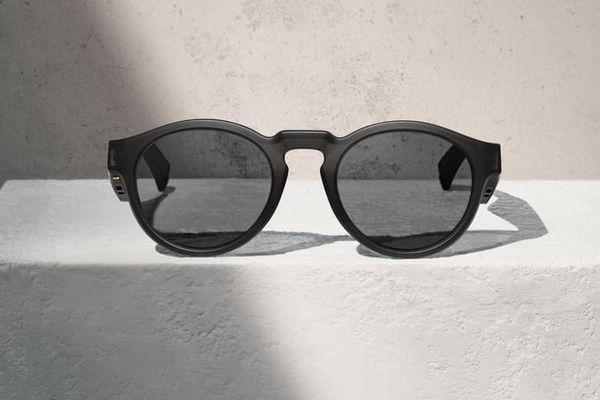
At first glance, the Bose Frames look like a pair of regular sunglasses. But they aren’t. They’re sunglasses that double as headphones — the slightly enlarged temples hide mini speakers that play sounds just for the wearer. With a multifunction button near the right temple, they do everything a regular pair of headphones can: They play music and podcasts and even answer phone calls, only they look like Ray-Bans. I was intrigued by the Frames when Bose announced them at South by Southwest last year, so when the company offered me the chance to test them out earlier this month, soon after their release, I had to find out whether they’d be actually useful — or another Google Glass or Snap Spectacles.
I tried the Rondo (the Frames also come in a Wayfarer-inspired Alto style), and the fit was comfortable and didn’t feel or look too large the way sunglasses sometimes do on my smaller face. The real test came when I started using them as headphones. No part of the Frames actually encloses the ear, so they essentially function as open-air headphones. While listening to music outside (the Frames pair via Bluetooth), I was aware of sounds around me but still heard my music at a good volume. Mehul Trivedi, director of Bose Frames, explained that the glasses are designed with “a speaker right near the front of your ear to guide that sound to you [and then] cancel in the far field,” so your fellow pedestrians don’t get an earful of whatever you’re blasting.
I tried them at home and in the office, too, to get a sense of just how private the music was, and though my husband and co-workers could hear some sound, they couldn’t hear enough to identify a specific song (Young the Giant’s “Superposition,” for the record). When I wore them outside, amidst other noise, on the other hand, no one could tell I was listening to music. Though I wasn’t going to get the deep, booming base or overall audio range of high-end headphones, the sound quality was perfectly fine for strolling.
I even went for an hour-long run in the Frames (the battery level dropped by 20 percent, putting its lifespan on par with most wireless Bluetooth earbuds) and heard every word of the podcast I was listening to while also hearing cars and bikes in my vicinity. Plus, they seamlessly connected to my Nike running app to give me audio updates on my distance and pace. And even though they aren’t designed for running, they didn’t bounce on my face at all.
What’s really unique about the Bose Frames compared to a regular pair of headphones is the audio-led augmented reality. While I love Google Maps for navigating an unfamiliar city, it would be nice not to be tethered to my phone while using it. And the Bose Frames solves that problem, seamlessly delivering directions in my ear without being distracting. While you’re probably already using your phone for all of these functions already, Trivedi explains that Bose is partnering with developers to release new apps that will take advantage of the glasses’ internal compass and hands-free functionality. For example, Navisens, an app coming out this month, will detect where you’re facing and share relevant information like a Yelp review or historical details. It could be a useful feature when you’re traveling and unfamiliar with a locale, even if some of us would prefer to just whip out our phones.
For now, the Frames are a promising novelty, though its potential hinges on what other apps might be coming (could an AR video game be far behind?). They’re nice-enough glasses and nice-enough headphones, but some situations just don’t call for the simultaneous use of both. They become useless once you’re indoors or it’s dark outside — unless you don’t mind being that person in sunglasses. They’re also made of plastic and don’t feel as nicely-made as a pair of Warby Parkers (which, it should be said, are half the price). I found the Frames to be a totally fun invention, though, with the possibility of becoming much more useful. Even as is, they’d make a great gift for someone about to go on a beach vacation or just a New Yorker who can’t remember to reach for both their Warbies and Air Pods in the morning.
The Strategist is designed to surface the most useful, expert recommendations for things to buy across the vast e-commerce landscape. Some of our latest conquests include the best acne treatments, rolling luggage, pillows for side sleepers, natural anxiety remedies, and bath towels. We update links when possible, but note that deals can expire and all prices are subject to change.







